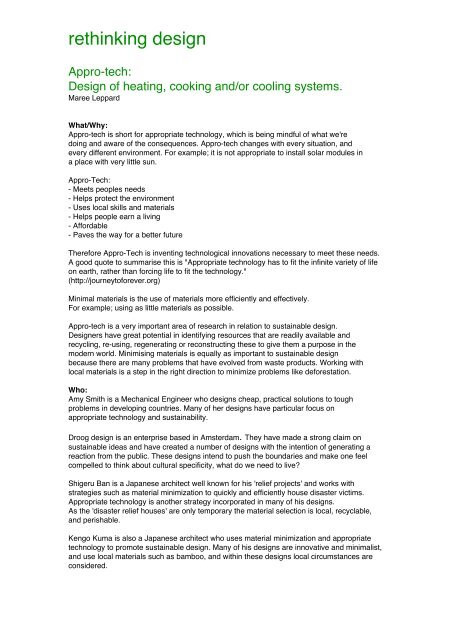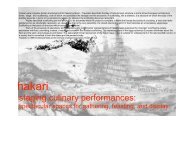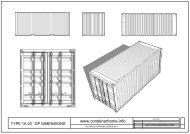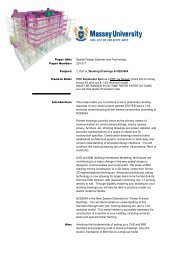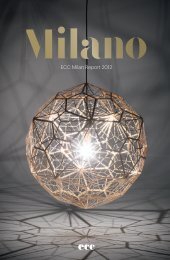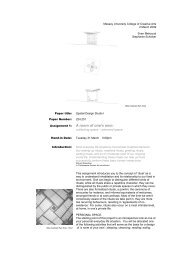rethinking design - Spatial Design@Massey
rethinking design - Spatial Design@Massey
rethinking design - Spatial Design@Massey
You also want an ePaper? Increase the reach of your titles
YUMPU automatically turns print PDFs into web optimized ePapers that Google loves.
ethinking <strong>design</strong><br />
Appro-tech:<br />
Design of heating, cooking and/or cooling systems.<br />
Maree Leppard<br />
What/Why:<br />
Appro-tech is short for appropriate technology, which is being mindful of what we're<br />
doing and aware of the consequences. Appro-tech changes with every situation, and<br />
every different environment. For example; it is not appropriate to install solar modules in<br />
a place with very little sun.<br />
Appro-Tech:<br />
- Meets peoples needs<br />
- Helps protect the environment<br />
- Uses local skills and materials<br />
- Helps people earn a living<br />
- Affordable<br />
- Paves the way for a better future<br />
Therefore Appro-Tech is inventing technological innovations necessary to meet these needs.<br />
A good quote to summarise this is "Appropriate technology has to fit the infinite variety of life<br />
on earth, rather than forcing life to fit the technology."<br />
(http://journeytoforever.org)<br />
Minimal materials is the use of materials more efficiently and effectively.<br />
For example; using as little materials as possible.<br />
Appro-tech is a very important area of research in relation to sustainable <strong>design</strong>.<br />
Designers have great potential in identifying resources that are readily available and<br />
recycling, re-using, regenerating or reconstructing these to give them a purpose in the<br />
modern world. Minimising materials is equally as important to sustainable <strong>design</strong><br />
because there are many problems that have evolved from waste products. Working with<br />
local materials is a step in the right direction to minimize problems like deforestation.<br />
Who:<br />
Amy Smith is a Mechanical Engineer who <strong>design</strong>s cheap, practical solutions to tough<br />
problems in developing countries. Many of her <strong>design</strong>s have particular focus on<br />
appropriate technology and sustainability.<br />
Droog <strong>design</strong> is an enterprise based in Amsterdam. They have made a strong claim on<br />
sustainable ideas and have created a number of <strong>design</strong>s with the intention of generating a<br />
reaction from the public. These <strong>design</strong>s intend to push the boundaries and make one feel<br />
compelled to think about cultural specificity, what do we need to live<br />
Shigeru Ban is a Japanese architect well known for his 'relief projects' and works with<br />
strategies such as material minimization to quickly and efficiently house disaster victims.<br />
Appropriate technology is another strategy incorporated in many of his <strong>design</strong>s.<br />
As the 'disaster relief houses' are only temporary the material selection is local, recyclable,<br />
and perishable.<br />
Kengo Kuma is also a Japanese architect who uses material minimization and appropriate<br />
technology to promote sustainable <strong>design</strong>. Many of his <strong>design</strong>s are innovative and minimalist,<br />
and use local materials such as bamboo, and within these <strong>design</strong>s local circumstances are<br />
considered.


